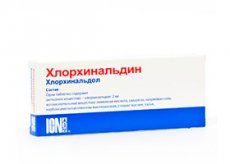Medical expert of the article
New publications
Preparations
Chloroquinaldine
Last reviewed: 03.07.2025

All iLive content is medically reviewed or fact checked to ensure as much factual accuracy as possible.
We have strict sourcing guidelines and only link to reputable media sites, academic research institutions and, whenever possible, medically peer reviewed studies. Note that the numbers in parentheses ([1], [2], etc.) are clickable links to these studies.
If you feel that any of our content is inaccurate, out-of-date, or otherwise questionable, please select it and press Ctrl + Enter.

Chlorquinaldine is an antiseptic with antimicrobial action, which is used locally for the treatment of dental diseases.
 [ 1 ]
[ 1 ]
Indications Chloroquinaldine
It is used for inflammation in the oral cavity, on the tongue or gums, and also for stomatitis and fungus in the mouth or throat after therapy with antibiotics.
 [ 2 ]
[ 2 ]
Release form
The product is produced in tablets, in the amount of 20 pieces inside a blister pack.
Pharmacodynamics
The active substance of the drug, chlorquinaldol, has a complex antiprotozoal, antibacterial and antimycotic effect.
It has activity against the following strains of pathogenic microbes: Staphylococcus aureus and Streptococcus pyogenes, Proteus vulgaris, Pseudomonas aeruginosa, Shigella and Salmonella, as well as Corynebacterium diphtheriae and Escherichia coli.
In addition, the drug affects protozoa (dysenteric amoeba, vaginal trichomonas and intestinal lamblia), as well as certain fungi.
 [ 3 ]
[ 3 ]
Pharmacokinetics
Chlorquinaldine is used locally. The absorption of the active element of the drug from the gastrointestinal tract is about 25%.
 [ 4 ]
[ 4 ]
Dosing and administration
The tablets taken must not be chewed - they must be sucked. The maximum daily dosage is 20 mg (10 tablets). The tablets are taken at intervals of 1-2 hours. If there is no positive result after 5 days of therapy, it is recommended to change the treatment regimen.
 [ 5 ]
[ 5 ]
Use Chloroquinaldine during pregnancy
The drug is almost not absorbed from the gastrointestinal tract, so the risk of complications in the fetus is extremely low. However, despite the fact that no tests have been conducted on the drug's effect on pregnancy, its use is permitted only in situations where the doctor believes that the benefit to the woman will be more likely than the possibility of problems in the fetus.
Since Chlorquinaldine has not been tested on breastfed infants, its use during lactation is prohibited.
Contraindications
Contraindication is the presence of intolerance to the elements of the drug. It is also prohibited to give to children, because there is no necessary clinical information for this group.
Side effects Chloroquinaldine
Side effects of the drug use are manifested in the form of burning or itching in the oral cavity. People with hypersensitivity experience allergic reactions - urticaria or rashes.
Storage conditions
Chlorquinaldine should be kept in a dark place, out of reach of small children. Temperature indicators are within 15-25°C.
 [ 8 ]
[ 8 ]
Shelf life
Chlorquinaldine is allowed to be used for 3 years from the date of manufacture of the drug.
Reviews
Chlorquinaldine is considered to be quite an effective drug for treating irritation or sore throat. Reviews note that the drug has a minimum of contraindications and side effects, and does not cause an overdose. Another advantage is its low cost.
Attention!
To simplify the perception of information, this instruction for use of the drug "Chloroquinaldine" translated and presented in a special form on the basis of the official instructions for medical use of the drug. Before use read the annotation that came directly to medicines.
Description provided for informational purposes and is not a guide to self-healing. The need for this drug, the purpose of the treatment regimen, methods and dose of the drug is determined solely by the attending physician. Self-medication is dangerous for your health.

